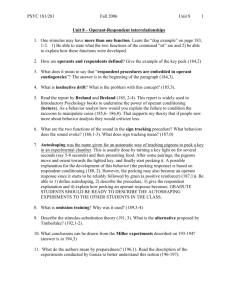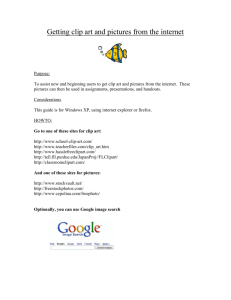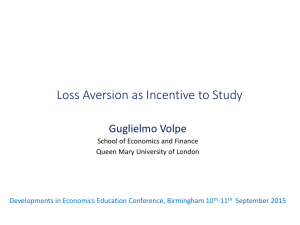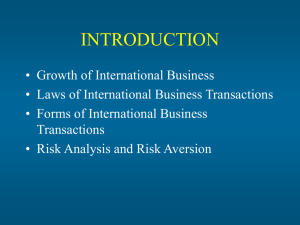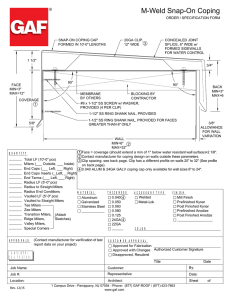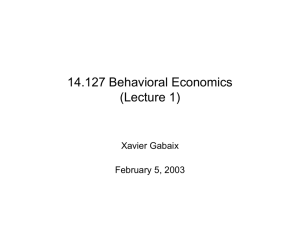More about Learning
advertisement
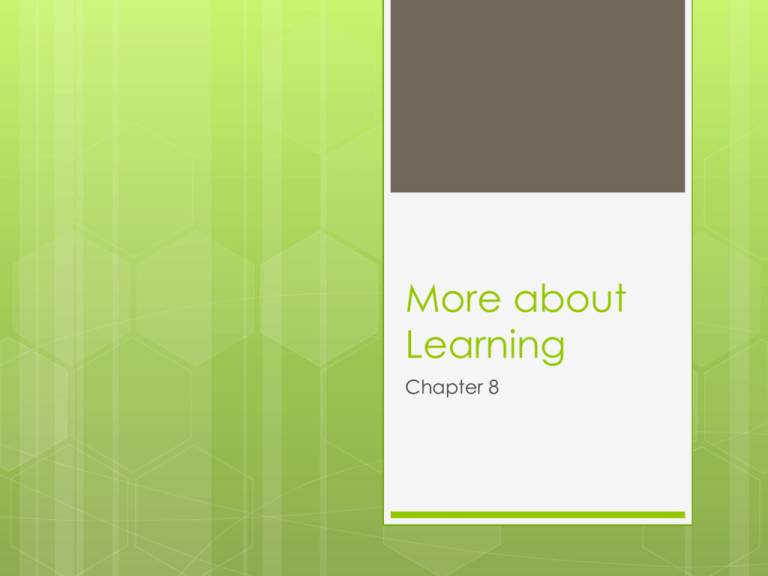
More about Learning Chapter 8 Biological Aspects of Learning Instinctive Drift: tendency of an animal to revert to instinctive behaviors that interfere with a conditioned response. The concept originated with B.F. Skinner's former students Keller Breland and Marian Breland when they tried to teach a raccoon to put tokens into a piggy bank. Gregory Kimble: “Just about any activity that an organism is capable of can be conditioned”. He was proven wrong many times. An animal’s capacity for conditioning is constrained at times by its biology. Environments are not the whole story. For example: Taste Aversion: Garcia: Learned Helplessness Martin Seligman The hopelessness and passive resignation an animal or human being learns when unable to avoid repeated aversive events John Garcia Taste aversion is a learned response to eating spoiled or toxic food. When taste aversion takes place, you avoid eating the foods that made you ill. Taste aversion can be so powerful that sometimes you also avoid the foods that you associate with an illness, even if the food did not cause the illness Wolfgang Kohler Insight Learning: type of learning or problem solving that happens all-of-asudden through understanding the relationships various parts of a problem rather than through trial and error. Sultan the chimp Video clip: Kohler Chimpanzees Video clip: Pigeon, box, and banana Cognitive Learning Learning by experience, touching, listening, or perceiving Acquisition of problem-solving abilities and with intelligence and conscious thought. Social Learning Theory Albert Bandura: social learning theory: behavior is learned from the environment through the process of observational learning. Clip: Bobo doll experiment Social and Emotional Learning Social and emotional learning (SEL) is the process through which children and adults acquire and effectively apply the knowledge, attitudes and skills necessary to understand and manage emotions, set and achieve positive goals, feel and show empathy for others, establish and maintain positive relationships, and make responsible decisions. Superstitions Learning and Superstitions: see clip on BF Skinner and superstitious behavior Behavior Modifications Biofeedback: a technique that involves using visual or auditory feedback to gain control over involuntary bodily functions. This may include gaining voluntary control over such things as heart rate, muscle tension, blood flow, pain perception and blood pressure. Self-Control separates us from our ancient ancestors and the rest of the animal kingdom, thanks to our large prefrontal cortices. Rather than responding to immediate impulses, we can plan, we can evaluate alternative actions, and we can refrain from doing things we'll regret. We can also take advantage of these innately human abilities by developing wisdom and willpower. Problem Focused Coping Taking Control – this response involves changing the relationship between yourself and the source of stress. Examples: escaping from the stress or removing the stress. Information Seeking – the most rational action. This involves the individual trying to understand the situation (e.g. using the internet) and putting into place cognitive strategies to avoid it in future. Information seeking is a cognitive response to stress. Evaluating the pros and cons of different options for dealing with the stressor. Emotion-focused coping involves trying to reduce the negative emotional responses associated with stress such as embarrassment, fear, anxiety, depression, excitement and frustration. This may be the only realistic option when the source of stress is outside the person’s control. Drug therapy can be seen as emotion focused coping as it focuses on the arousal caused by stress not the problem. External locus of control The belief that events in one’s life, whether good or bad, are caused by uncontrollable factors such as the environment, other people, or a higher power. Internal locus of control The belief that events in one’s life, whether good or bad, are caused by controllable factors such as one’s attitude, preparation, and effort.
